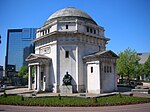Centenary Square

Centenary Square is a public square on the north side of Broad Street in Birmingham, England, named in 1989 to commemorate the centenary of Birmingham achieving city status. The area was an industrial area of small workshops and canal wharves before it was purchased by the council in the 1920s for the creation of a grand civic centre scheme to include museums, council offices, cathedral and opera house. The scheme was abandoned after the arrival of World War II with only the Hall of Memory and half of the planned Baskerville House complete. After the war the scheme was revived in a simpler form however the council never managed to implement the design. In 1991 the square was redesigned to complement the new International Convention Centre with new paving, railings and lamps designed by artist Tess Jaray, a fountain and several sculptures. During the construction and opening of the Library of Birmingham on the square in 2013 several of the elements of the 1991 design were removed and a library amphitheatre was built into the square. In 2014 a design competition was held to redesign the square. Construction of the redesigned square began in 2017 and was largely complete in 2019. The square is used as a staging area for many of the city's main cultural events including the Frankfurt Christmas Market, Arts Festivals, Remembrance Day Services, New Year's Celebrations and during Christmas hosts a temporary ice rink and Ferris wheel.
Excerpt from the Wikipedia article Centenary Square (License: CC BY-SA 3.0, Authors, Images).Centenary Square
Centenary Square, Birmingham Ladywood
Geographical coordinates (GPS) Address External links Nearby Places Show on map
Geographical coordinates (GPS)
| Latitude | Longitude |
|---|---|
| N 52.4791 ° | E -1.9082 ° |
Address
Centenary Square
Centenary Square
Birmingham, Ladywood
England, United Kingdom
Open on Google Maps










